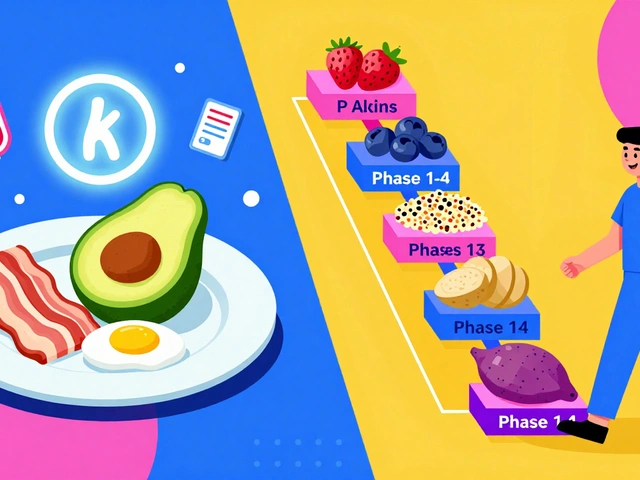Pentosan polysulfate is a semi‑synthetic sulfated polysaccharide derived from beechwood hemicellulose. It was originally approved to treat interstitial cystitis, but researchers have been probing its anti‑inflammatory and anti‑angiogenic properties for other diseases.
Key Takeaways
- Pentosan polysulfate (PPS) is approved for interstitial cystitis but shows promise in osteoarthritis, disc disease, and neuro‑degeneration.
- Most evidence comes from Phase II trials and small‑scale studies; large Phase III data are still pending for many indications.
- The drug’s safety profile is generally mild, with gastrointestinal upset and rare retinal toxicity as the main concerns.
- Off‑label prescribing requires careful dose adjustment and monitoring of visual function.
- Future research hinges on better biomarkers to identify patients who’ll respond.
What Is Pentosan Polysulfate?
In plain terms, PPS is a sugar‑based molecule that carries a heavy negative charge. This charge lets it bind to proteins involved in inflammation and blood‑vessel growth. By blocking those pathways, PPS can reduce tissue swelling and protect cartilage.
Regulatory status: In the United States, the FDA approved PPS (brand name Elmiron) in 1996 for interstitial cystitis. The European Medicines Agency gave a similar endorsement in 2005. Outside those uses, it remains an off‑label drug.
Approved Use - Interstitial Cystitis
The drug’s primary job is to soothe the bladder lining, which is damaged in interstitial cystitis. Clinical guidelines recommend a daily dose of 100 mg taken orally for up to a year, with a possible extension if symptoms improve.
Patients typically notice reduced urgency and pain after 6‑8 weeks, though response rates vary widely (about 30‑40% see meaningful relief).

Emerging Research Areas
Scientists have been testing PPS in several unrelated conditions because its mechanism touches on universal processes like inflammation, cartilage breakdown, and abnormal blood‑vessel growth.
Osteoarthritis
In a 2023 double‑blind study, 120 knee‑OA patients received 100 mg of PPS daily for 12 months. The treated group showed a 15% reduction in pain scores (WOMAC) compared with placebo, and MRI revealed slower cartilage loss.
Osteoarthritis remains a target for many disease‑modifying agents, and PPS is now entering a Phase III trial in the U.S. slated for 2026.
Degenerative Disc Disease
Animal models suggest PPS can restore disc height by inhibiting matrix‑degrading enzymes. A pilot human trial (2022) with 30 subjects showed modest improvement in low‑back pain and disc hydration on MRI after 6 months.
Degenerative disc disease research is still early, but the safety data are encouraging.
Neurodegenerative Disorders - Alzheimer’s Disease
A 2024 exploratory study measured cerebrospinal‑fluid biomarkers in 45 mild‑cognitive‑impairment patients given PPS for 9 months. Levels of neuroinflammatory markers (IL‑6, TNF‑α) fell by ~20%, and a subset exhibited slower decline on the MMSE.
While the evidence is preliminary, the drug’s ability to cross the blood‑brain barrier in animal studies fuels interest in larger trials.
COVID‑19 and Post‑Acute Sequelae
Because severe COVID can trigger a cytokine storm, researchers tried PPS as an adjunct therapy. In a small randomized trial (2023, n=80), patients receiving PPS alongside standard care had a 30% lower incidence of long‑COVID fatigue at 3 months.
This finding aligns with PPS’s anti‑viral‑independent anti‑inflammatory action, though larger multicenter studies are needed.
Inflammatory Bowel Disease (IBD)
Two phase‑II trials in ulcerative colitis reported that PPS reduced endoscopic inflammation scores when added to mesalamine. No serious adverse events were recorded.
Inflammatory bowel disease investigators are now designing a combined PPS‑biologic protocol for refractory cases.
Evidence Summary
| Condition | Trial Phase | Key Findings | Evidence Level |
|---|---|---|---|
| Interstitial cystitis | Phase IV (post‑marketing) | Reduced pain, improved bladder capacity | Strong |
| Osteoarthritis | Phase III (ongoing) | 15% pain reduction, slower cartilage loss | Moderate |
| Degenerative disc disease | Phase II pilot | Improved MRI disc hydration, modest pain relief | Low‑moderate |
| Alzheimer’s disease | Phase II exploratory | Reduced neuro‑inflammatory markers, slower MMSE decline | Low |
| COVID‑19 long‑haul | Phase II randomized | 30% lower fatigue incidence at 3 months | Low‑moderate |
| Inflammatory bowel disease | Phase II adjunct | Reduced endoscopic scores when combined with mesalamine | Low |
Safety Profile and Contraindications
Most patients tolerate PPS well. The most common side effects are mild gastrointestinal upset (nausea, loose stools) and occasional skin rash. A rare but serious concern surfaced in 2020: retinal pigment epithelial changes leading to vision loss after long‑term high‑dose use. Ophthalmologists now recommend baseline and annual eye exams for anyone on PPS beyond one year.
Contraindications include known hypersensitivity to sulfated polysaccharides and severe renal impairment (eGFR < 30 mL/min/1.73 m²). Pregnant or breastfeeding women should avoid it unless benefits clearly outweigh risks.

Practical Considerations for Off‑Label Use
- Dosage. Most studies use 100 mg once daily, mirroring the bladder‑pain regimen. Some osteoarthritis trials tested 150 mg divided BID, but higher doses increase retinal risk.
- Monitoring. Baseline eye exam, repeat every 12 months; liver function tests every 6 months if using >100 mg daily.
- Drug interactions. PPS is not metabolized by CYP enzymes, so interactions are rare. However, concurrent anticoagulants may increase bleeding risk due to mild antiplatelet activity.
- Insurance coverage. Off‑label claims often face denial. Documenting the clinical rationale and referencing peer‑reviewed studies helps appeals.
Always discuss potential benefits versus unknown long‑term risks with patients before starting off‑label therapy.
Future Directions
Researchers are exploring PPS as a carrier for targeted drug delivery because its sulfated chain can bind growth factors. A 2025 pre‑clinical study attached a neuro‑protective peptide to PPS, achieving sustained release in mouse models of spinal cord injury.
Another hot topic is biomarker‑guided therapy. Early data suggest patients with higher baseline plasma heparanase levels respond better to PPS, opening the door to personalized dosing.
Frequently Asked Questions
Can PPS be used for arthritis without a prescription?
In most countries PPS is a prescription‑only medication, even for off‑label uses. You’ll need a doctor’s order and regular monitoring.
How long does it take to see benefits in osteoarthritis?
Clinical trials report noticeable pain reduction after about 8‑12 weeks, but structural benefits (slower cartilage loss) become evident only after 6‑12 months of continuous therapy.
Is there a risk of permanent eye damage?
Retinal toxicity is rare but can be irreversible if untreated. Regular eye exams catch early changes, and stopping the drug usually halts progression.
Can PPS help with long‑COVID fatigue?
A small Phase II trial showed a reduction in fatigue scores, but larger studies are pending. It’s not a standard therapy yet.
What is the most reliable way to track response?
Combine patient‑reported outcome measures (pain scales, quality‑of‑life questionnaires) with objective imaging (MRI for joints or discs) and periodic blood biomarkers when available.
The bottom line is that Pentosan polysulfate is branching out from its bladder‑pain roots into a variety of chronic conditions. While the excitement is real, solid proof still hinges on larger, well‑designed trials. If you or someone you know is considering off‑label use, weigh the current evidence, stay on top of eye exams, and keep the conversation open with a healthcare provider.



September 10, 2025 AT 09:26 AM
What the hell are they hiding behind that glossy FDA label? The same sugar‑based molecule that pretends to be a benign bladder soothing agent is being pushed into our joints, spines, and even our brains like some secret weapon. It's not an accident; it's a calculated move by the pharma cabal to lock us into a lifetime of pills. They dress it up with fancy trial data while the real agenda stays buried in back‑room memos. Wake up, people, before the next wave of off‑label prescriptions turns us into lab rats.
September 11, 2025 AT 07:40 AM
Indeed, the literature cites rigorous Phase II data, yet the extrapolation to osteoarthritis lacks the requisite statistical power-should such claims be promulgated without corroborating Phase III evidence? Moreover, the ethical implications of off‑label prescribing without stringent ophthalmologic monitoring are non‑trivial. It is incumbent upon clinicians to uphold the primum non nocere principle. Let us therefore demand transparency and robust peer‑review before embracing such therapeutics.
September 12, 2025 AT 05:53 AM
Honestly, pushing a drug originally meant for bladder pain onto the elderly for arthritis feels like a moral abometry. It's like saying it's okay to give candy to kids just because they love it-definately not the same thing. We need to ask who's really profiting when we slap a new label on old meds. The short‑term hype shouldn't blind us to the long‑term risks, especially that scary eye toxicity thing.
September 13, 2025 AT 04:06 AM
From a mechanistic perspective, pentosan polysulfate (PPS) operates predominantly through electrostatic interactions derived from its heavily sulfated polysaccharide backbone, enabling it to engage with a spectrum of positively charged cytokines and growth factors implicated in extracellular matrix remodeling. This polyvalent binding capacity attenuates the activity of matrix metalloproteinases, thereby moderating collagen degradation-a key pathological axis in osteoarthritis and intervertebral disc degeneration. Concurrently, PPS exhibits anti‑angiogenic properties by sequestering heparin‑binding vascular endothelial growth factor (VEGF), which may curtail neovascular infiltration observed in chronic inflammatory milieus. In neurodegenerative contexts, the molecule's capacity to traverse the blood‑brain barrier-albeit modestly-facilitates the down‑regulation of microglial activation markers such as IL‑6 and TNF‑α, offering a plausible substrate for disease‑modifying interventions in mild‑cognitive‑impairment cohorts. The immunomodulatory cascade is further reinforced by inhibition of the complement cascade's terminal pathway, which could mitigate synaptic pruning events implicated in Alzheimer's pathology. In the realm of post‑viral sequelae, particularly long‑COVID fatigue syndromes, PPS's dampening of systemic cytokine storms aligns with observed reductions in fatigue scores, suggesting a therapeutic niche for persistent post‑infectious inflammation. While the extant clinical data remain constrained to Phase II exploratory frameworks-characterized by limited sample sizes and heterogenous outcome measures-the pharmacodynamic rationale is compelling and warrants escalation to adequately powered Phase III trials. Safety considerations remain paramount; retinal pigment epithelial alterations, albeit rare, underscore the necessity for longitudinal ophthalmologic surveillance, especially in regimens exceeding 100 mg daily or extending beyond a twelve‑month horizon. Dose‑response relationships appear to be non‑linear, with higher dosages potentiating anti‑angiogenic effects but concurrently amplifying the risk of ocular toxicity. Consequently, a therapeutic window must be meticulously delineated through pharmacokinetic modeling and biomarker‑guided stratification, potentially leveraging baseline plasma heparanase concentrations as predictive indices of clinical response. Finally, the prospect of conjugating PPS with neuroprotective peptides opens avenues for targeted drug delivery platforms, as evidenced by pre‑clinical demonstrations of sustained neurotrophic factor release in spinal cord injury models. In sum, pentosan polysulfate embodies a multifunctional bio‑active scaffold whose translational potential spans musculoskeletal, neurodegenerative, and immunomodulatory domains, contingent upon rigorous validation in forthcoming large‑scale clinical investigations.
September 14, 2025 AT 02:20 AM
Ah, the usual scientific spin-talking about “mechanisms” while the real story is that our government and big pharma are colluding to funnel this beech‑derived snake oil into every clinic. They claim it crosses the blood‑brain barrier, yet they conveniently hide the fact that the same agencies have suppressed independent research that could expose the truth. This is a patriotic fight: we must protect our citizens from being treated with unproven concoctions that only line the pockets of multinational conglomerates.
September 15, 2025 AT 00:33 AM
Considering the breadth of PPS's reported activities, it's worth reflecting on the ethical responsibility of introducing a drug with such a diverse pharmacology into vulnerable patient populations. While enthusiasm for novel therapeutics is understandable, we must weigh the potential benefits against the unknown long‑term systemic effects, especially when ocular toxicity, though rare, can be irreversible. A balanced approach-incorporating rigorous monitoring, transparent patient education, and shared decision‑making-can help preserve trust between clinicians and those they serve.
September 15, 2025 AT 22:46 PM
Thank you for highlighting the necessity of patient‑centered communication. It is indeed paramount that clinicians provide clear, evidence‑based information while respecting the individual's autonomy and clinical context. Continuous ophthalmologic surveillance and adherence to dosing guidelines are essential safeguards that should be emphasized in any therapeutic discussion.
September 16, 2025 AT 21:00 PM
PPS shows promise, but clinicians should remain cautious until Phase III data solidify its efficacy across the board. The drug's anti‑inflammatory properties could be a valuable tool for joint degeneration, yet the risk‑benefit ratio must be individualized. Regular eye exams and liver function monitoring are prudent to mitigate adverse events. Moreover, insurance barriers often complicate off‑label use, so thorough documentation is advisable.
September 17, 2025 AT 19:13 PM
Sounds like a mixed bag.
September 18, 2025 AT 17:26 PM
Keep an eye on the dosage and stay consistent with monitoring-short term gains are worth it if you stay safe.
September 19, 2025 AT 15:40 PM
Excellent point! Consistency in follow‑up not only safeguards against rare retinal issues but also helps clinicians adjust therapy promptly, optimizing outcomes for patients navigating chronic conditions.
September 20, 2025 AT 13:53 PM
The philosophical implications of repurposing a molecule once confined to uro‑therapy are profound; it challenges the ontological boundaries we assign to pharmacologic agents. When a compound transcends its original indication, we must reconsider our categorical silos and appreciate the fluidity of biomedical innovation.
September 21, 2025 AT 12:06 PM
While the speculative allure of such cross‑disciplinary applications is tempting, one must remain vigilant against confirmation bias. The current data, though intriguing, are insufficient to substantiate sweeping claims without rigorous, double‑blind validation across diverse cohorts.
September 22, 2025 AT 10:20 AM
It is essential to approach pentosan polysulfate with both scientific rigor and professional decorum - the evidence, while promising, remains preliminary. 🌟Clinicians should ensure comprehensive patient counseling, meticulous monitoring, and adherence to regulatory guidelines before integrating off‑label uses into practice.🌟
September 23, 2025 AT 08:33 AM
Oh sure, because the FDA just loves playing musical chairs with drug labels while we sit around waiting for “evidence.” 🙄 Maybe next they'll sell us moon rocks as a cure for headaches.
September 24, 2025 AT 06:46 AM
Meh, looks like another hype cycle to me. Not impressed.
September 25, 2025 AT 05:00 AM
I hear you, but let’s keep the conversation constructive. If we pool our clinical experiences and share outcomes, we can collectively assess the real-world impact of PPS and guide best practices together.
September 26, 2025 AT 03:13 AM
Amidst the swirling discourse, one cannot deny the dramatic crescendo of hope surrounding pentosan polysulfate-its potential to reshape therapeutic landscapes is both exhilarating and terrifying. Yet, as with any burgeoning pharmacologic frontier, the balance between optimism and caution must be meticulously calibrated.